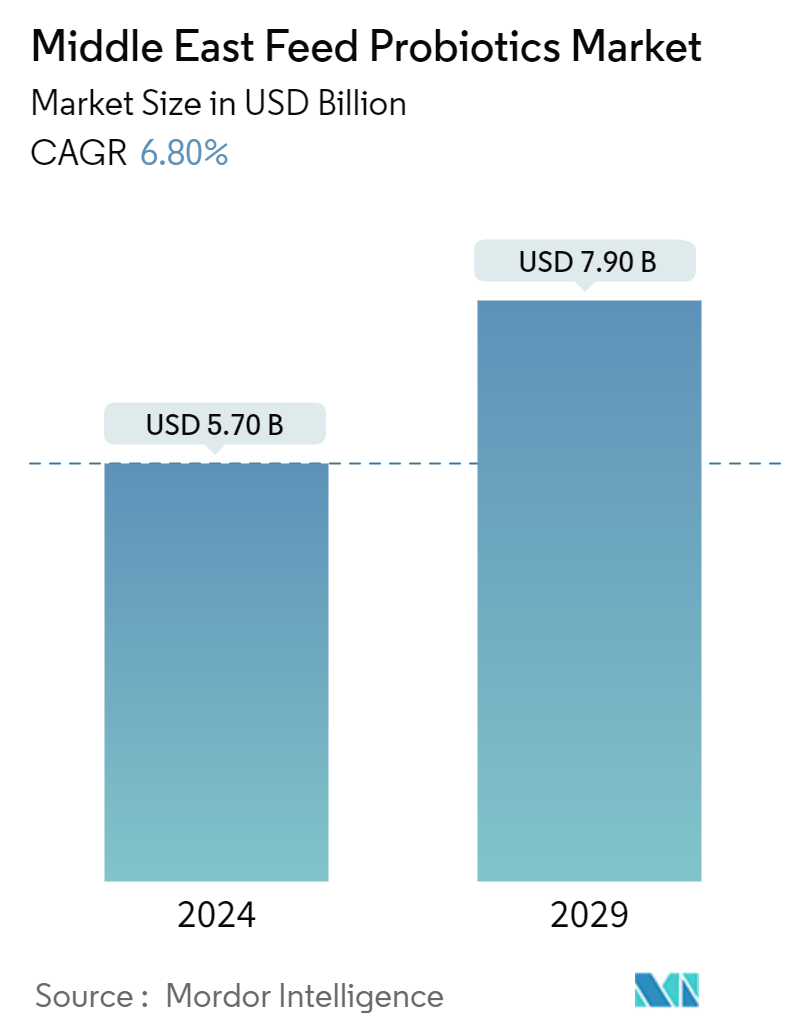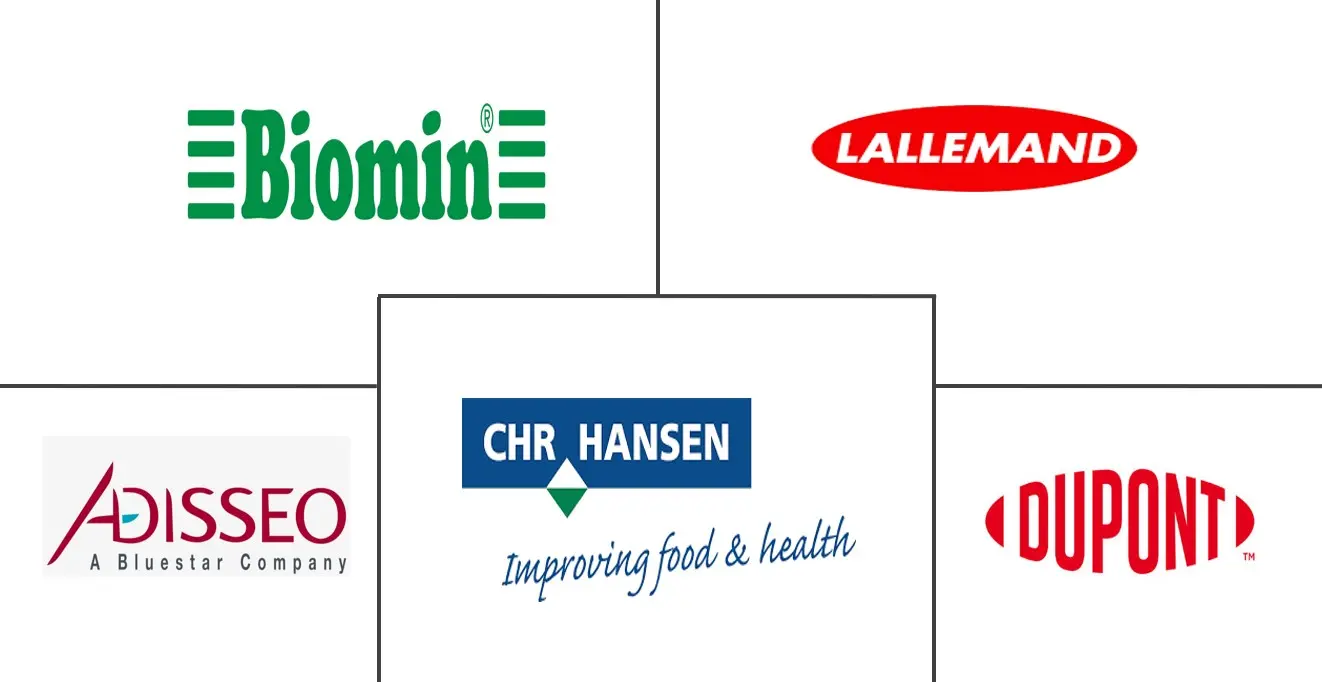
| Study Period | 2019 - 2029 |
| Base Year For Estimation | 2023 |
| Forecast Data Period | 2024 - 2029 |
| Market Size (2024) | USD 5.70 Billion |
| Market Size (2029) | USD 7.90 Billion |
| CAGR (2024 - 2029) | 6.80 % |
| Market Concentration | Low |
Major Players
*Disclaimer: Major Players sorted in no particular order |
Middle East Feed Probiotics Market Analysis
The Middle East Feed Probiotics Market size is estimated at USD 5.70 billion in 2024, and is expected to reach USD 7.90 billion by 2029, at a CAGR of 6.80% during the forecast period (2024-2029).
- The market is being driven by several factors, including rising awareness about the benefits of probiotics in animal health, and increasing demand for high-quality meat and dairy products in the region. According to the Organization for Economic Cooperation and Development (OECD), Saudi Arabia's poultry consumption increased from 1,392 thousand metric tons in 2022 to 2,118 thousand metric tons in 2023. Similarly, beef consumption rose from 219.7 thousand metric tons in 2022 to 226.1 thousand metric tons in 2023. This growing demand for quality meat has created opportunities for feed manufacturers to enhance animal productivity, leading to increased usage of feed probiotics and driving growth in the market.
- Moreover, fish holds significant nutritional value for the people of Oman, with both marine and freshwater fish consumption being notably high, due to the nearby marine line. For instance, in 2022, according to the Fisheries Development of Oman, the per capita consumption of fish was 27 kilograms, whereas it is 17 kilograms all over the world. This heightened fish consumption naturally escalates the demand for probiotics. Additionally, given their ability to control pathogens through various mechanisms, are increasingly being used in feed in aquaculture in Oman.
- Besides, initiatives by various Middle Eastern government agencies to boost the animal feed probiotic market growth have increased over the years. For instance, in 2022, The Abu Dhabi Agriculture and Food Safety Authority (ADAFSA) entered into agreements with 13 leading local companies to establish partnerships in selling and marketing high-quality grass and concentrated feed, including probiotic feed. These agreements aim to fulfill the requirements of the UAE livestock sector, like camel and horse, and support the development of the feed industry.
Middle East Feed Probiotics Industry Segmentation
Feed probiotics refer to the probiotics (beneficial micro-organisms) incorporated into base mixes and compound forms, with premix producers, farmers, compound feed producers, and base mix and concentrate producers as end consumers. The scope of the report does not include premix-based probiotics. The market is segmented by type (lactobacilli, bifidobacteria, and other types), application (ruminant, poultry, swine, aquaculture, and other applications), and geography (Saudi Arabia, United Arab Emirates, Egypt, Turkey, Jordan, and Rest of Middle East). The report offers market size and forecasts in terms of value (USD) for all the above segments.
| Lactobacilli |
| Bifidobacteria |
| Other Types |
| Ruminants |
| Poultry |
| Swine |
| Aquaculture |
| Other Applications |
| Saudi Arabia |
| Egypt |
| United Arab Emirates |
| Turkey |
| Jordan |
| Rest of Middle East |
Middle East Feed Probiotics Market Size Summary
The Middle East feed probiotics market is experiencing significant growth, driven by the increasing demand for sustainable livestock farming and the rising health consciousness among consumers. Probiotics are becoming essential in the animal feed industry, particularly for farm livestock, companion animals, and aquaculture, as they help reduce clinical diseases and enhance growth rates. The market is segmented by product type, with lactobacilli holding a substantial share, and by animal type, where ruminants and poultry are the primary consumers. The aquaculture sector in Egypt is notably adopting probiotics to improve fish health and production efficiency, aligning with the region's growing trade in animal-based products. The demand for meat, especially in countries like the United Arab Emirates, is fueling the need for feed probiotics to ensure the sustainable production of high-quality animal proteins.
Saudi Arabia leads the Middle Eastern feed probiotics market, supported by its substantial livestock population and the adoption of compound feed enriched with probiotics. The country's focus on improving animal health standards and reducing antibiotic use in meat is creating opportunities for probiotic ventures. Major players in the market, such as Adisseo, Dupont, Biomin, and Chr. Hansen Holding AS, are expanding their operations and production capacities to meet the growing demand. The market's fragmentation indicates a competitive landscape, with companies actively seeking to enhance their presence in the region. The collaboration between global leaders like Adisseo and Novozymes to launch probiotics for poultry further underscores the market's potential for growth and innovation.
Middle East Feed Probiotics Market Size - Table of Contents
1. MARKET DYNAMICS
- 1.1 Market Overview
-
1.2 Market Drivers
- 1.2.1 Surge in Livestock Meat Production Drives the Market
- 1.2.2 Focus on Animal Nutrition and Health
- 1.2.3 Increasing Support from Government Institutions
-
1.3 Market Restraints
- 1.3.1 Growing Shift Toward Vegan-based Diet
- 1.3.2 Fluctuating Raw Material Costs
-
1.4 Industry Attractiveness - Porter's Five Forces Analysis
- 1.4.1 Bargaining Power of Suppliers
- 1.4.2 Bargaining Power of Consumers
- 1.4.3 Threat of New Entrants
- 1.4.4 Threat of Substitute Products
- 1.4.5 Intensity of Competitive Rivelry
2. MARKET SEGMENTATION
-
2.1 Type
- 2.1.1 Lactobacilli
- 2.1.2 Bifidobacteria
- 2.1.3 Other Types
-
2.2 Application
- 2.2.1 Ruminants
- 2.2.2 Poultry
- 2.2.3 Swine
- 2.2.4 Aquaculture
- 2.2.5 Other Applications
-
2.3 Geography
- 2.3.1 Saudi Arabia
- 2.3.2 Egypt
- 2.3.3 United Arab Emirates
- 2.3.4 Turkey
- 2.3.5 Jordan
- 2.3.6 Rest of Middle East
ME Feed Probiotics Market Research FAQs
How big is the Middle East Feed Probiotics Market?
The Middle East Feed Probiotics Market size is expected to reach USD 6.09 billion in 2025 and grow at a CAGR of 6.80% to reach USD 8.46 billion by 2030.
What is the current Middle East Feed Probiotics Market size?
In 2025, the Middle East Feed Probiotics Market size is expected to reach USD 6.09 billion.


